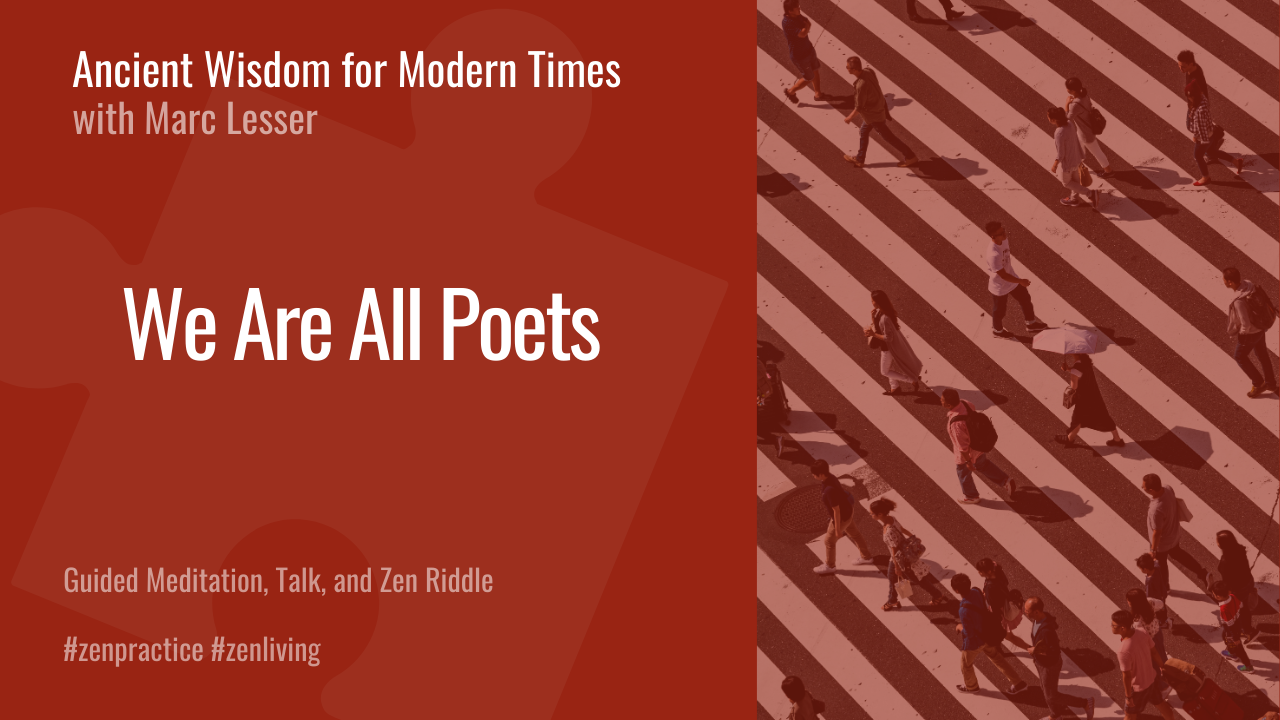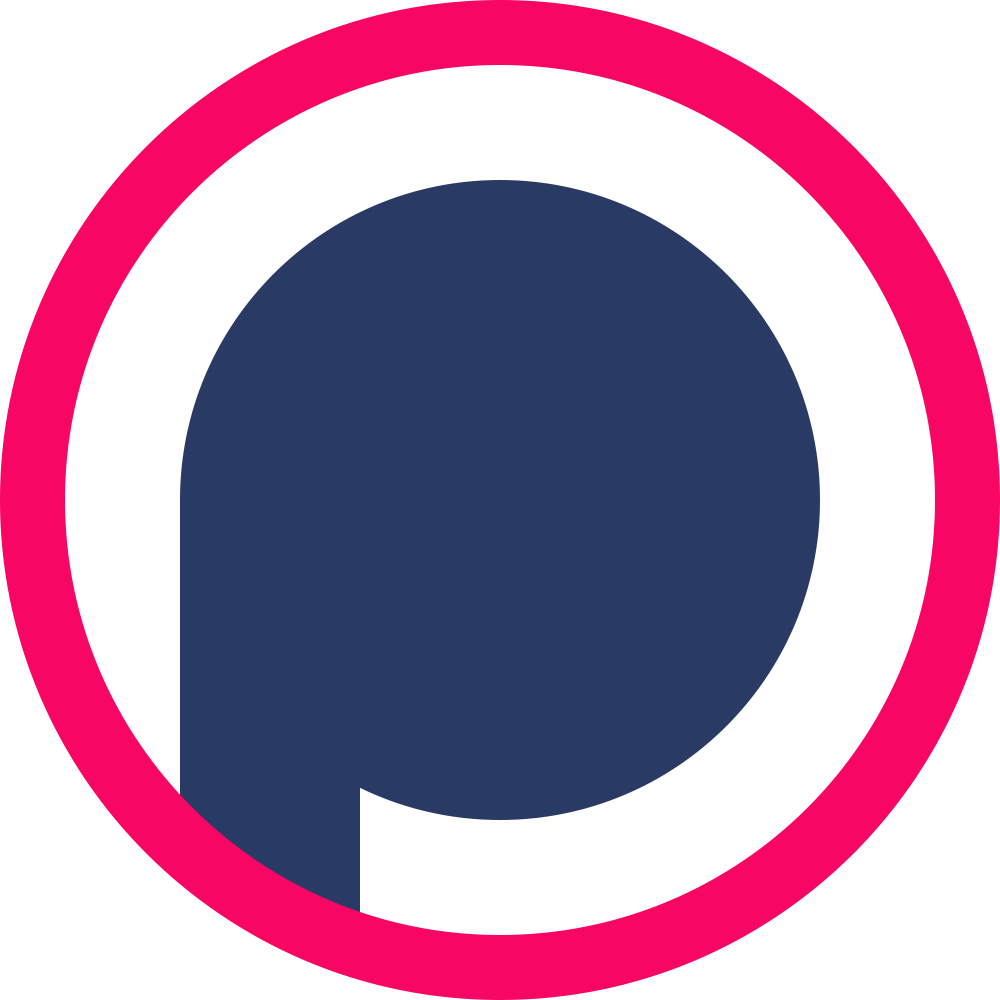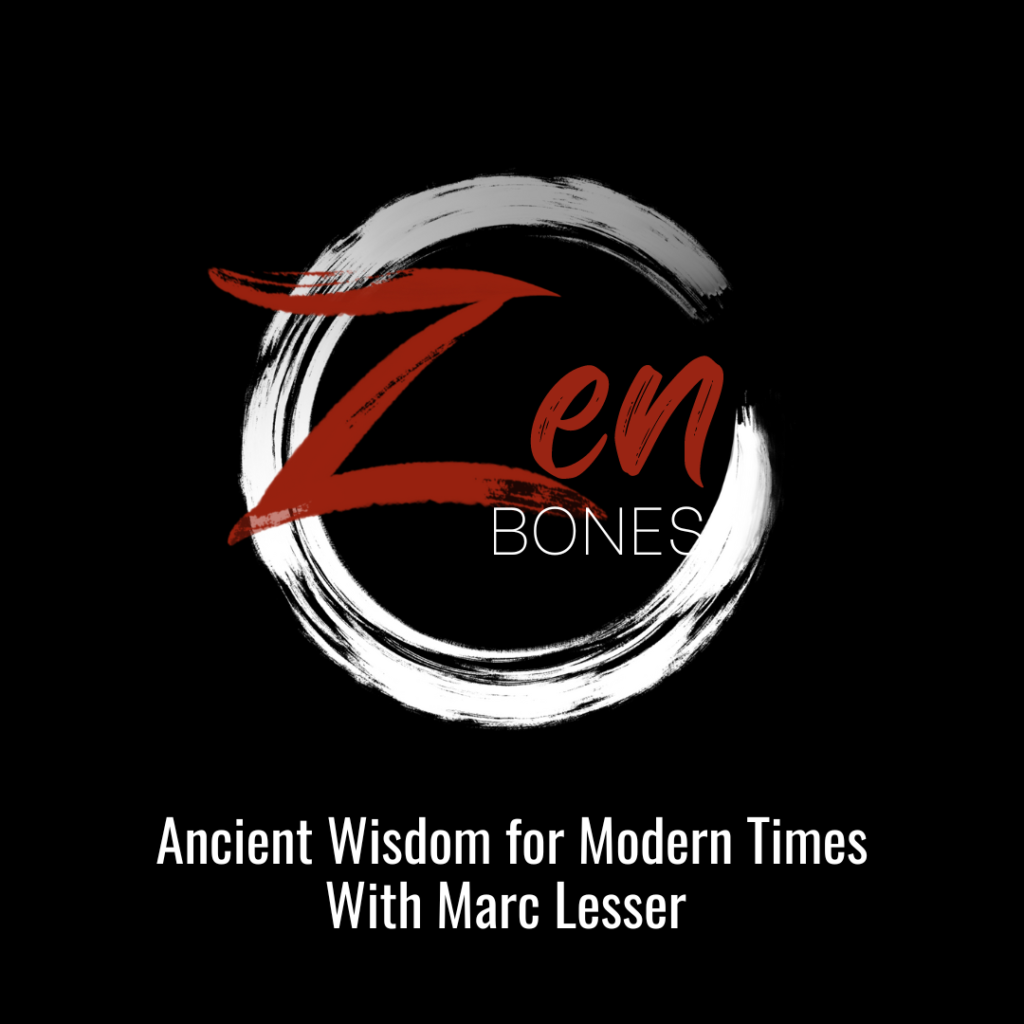We begin today’s episode with a short guided meditation focused on being present, fully here with nothing to accomplish. I give a short talk on embracing the mind of the poet and the mind of the business person, exploring these distinctions and lack of distinctions and how we can live and work and play with more meaning and connection.
And today’s Zen Puzzler comes from a traditional koan about a buffalo jumping through a window. The aim of this puzzler is about letting go of our predicting minds and instead seeing the world as fresh and mysterious.
EPISODE TRANSCRIPT
[music]
Marc Lesser: Welcome to Zen Bones. This is Marc Lesser. Zen Bones is a bi-weekly podcast featuring conversations with leading teachers and activists and an exploration of Zen teachings and practices. Please support our work by making a donation at marclesser.net/donate. We begin today’s episode with a short guided meditation focused on being present here with nothing to accomplish and then do a short talk on embracing the mind of the poet and the mind of the business person. Exploring these distinctions and lack of distinctions in how we live and work and play.
Today’s Zen puzzler comes from a traditional koan about a buffalo jumping through a window. The aim of this puzzler is about letting go of our predicting minds and instead seeing the world as fresh. Seeing through the world of possibility. I hope you enjoy today’s episode. Now let’s begin with a few minutes of sitting practice together.
[bell ringing]
[bell ringing]
[bell ringing]
Marc: Dropping in as much as possible. Dropping into this place where there’s nothing to accomplish. Nothing that needs to be changed or improved. Bringing attention to the body. Finding a way to sit where you can be relaxed, comfortable, and alert at the same time. Noticing the whole body. Relaxing the muscles in the face, relaxing the jaw, shoulders, back, legs, feet. These amazing bodies that we take for granted, usually until something hurts or goes wrong. If there’s anything hurting, giving that some attention. I’ve been paying particular attention to my right foot. I’m giving it some attention right now and loosening the muscles in the bottom of my foot.
Wherever, whatever needs attention for you. Noticing the breath, bringing attention to the breath. Simply allowing the breath to be full and fluid. Breathing in. I know that I’m breathing in. Breathing out. I’m aware. I know that I’m breathing out. It’s one of the earliest teachings of the historical Buddha as the path toward freedom is awareness of the breath. Noticing any, what your approach is. What feelings or mood you’re bringing to this time right now. Whatever that might be, inserting some sense of warm-hearted curiosity. Warm-hearted curiosity. What is it like to be here? What is it like to be alive right now? Let it all go, to let it go. Fading away, right? Fading, let it fade away. No forcing necessary. Keeping it simple. Keeping it simple. Coming back to the breath. Back to the body. Here. Now. Alive. I’m going to ring the bell. Please feel free to continue sitting for as long as you would like to.
[music]
Marc: Finding your inner poet and your inner business person. Finding or embracing. Embracing your inner poet and inner business person. This is what I want to talk about today. I think regardless of our work roles or our usual identities, I think we can all benefit and find greater clarity, meaning, satisfaction in embracing our inner poet as well as our inner business person. I don’t usually think of myself as a poet since I don’t write much poetry. I do love poetry. I do associate as feeling like I’m a business person in a strange way. I think when I was a young person in college, I would not have associated with business people.
There was a certain resistance that I had. I think I had no experience with the world of business, just had some idea. I noticed today, especially it’s interesting, I joke that my Zen friends, my Zen community thinks of me as a business person. I think my business friends, the people in the business community think of me as a Zen student or Zen teacher. It’s interesting just to be curious about these identities for ourselves or for others. What is it that what resistance do we have? Do you have about thinking about poetry or thinking about business?
I think poets and business people there’s our artistic minds and our getting stuff done minds. I think both the mind of the poet and the mind of business people can be quite creative. Through the perspective of poets, our lives I think are mysterious and sacred. I felt this the other day holding a young a newborn baby in my hands, my grandson who miraculously came out of my daughter’s body.
I’ve also recently accompanied a good friend through the dying process. I was in London recently with a good old friend helping her and it’s funny I think she thought I was helping but really she was helping me. She was opening my perspective and body to courageously facing death. Saying hello and goodbye at the same time. This feeling that we are always immersed in again this
holding my newly-born grandson and being with someone as she was dying. For me, at the same time, I’m training leaders in how to listen more attentively, to be more effective. I find the mind of the businessperson is making decisions, leadership presence, and having difficult conversations. As a businessperson, there’s the mind of needing to be responsive, to keep our calendar straight, to be tracking finances, and to be tracking people. Interesting, I think, the mind of a poet and the mind of a businessperson. Maybe they probably overlap in many places, but one is about finding more clarity, right? I think clarity. I’ve been thinking a lot about this topic because I have a fairly new book out called Finding Clarity. One of the things that I write about is, in this book, I say, to me, clarity begins with acknowledging and embodying that the world is not always what it seems. A tree on one level is just a tree. A tree can be dissected and explained in biological terms, yet, when looked at from the perspective of larger reality, a tree is a complete mystery.
We don’t really know what it is or how it got here. The same is true of everything, including us. We humans here on earth, birth, life, death, blood, hearts and hands, stone and sky, consciousness, all are mysteries, sacred mysteries to behold with wonder and awe. Clarity means seeing the world from both perspectives, the ordinary and the everyday, where a tree is just a tree, and the mysterious, which means acknowledging the unknown source of reality.
Clarity is the larger reality. It means seeing beyond or outside of these dualistic, relative ways of perception. On this level, clarity dissolves distinctions. It’s interesting, right? The distinction of the mind of a poet and the distinction of the mind of a business person, and I think we both need to live in a distinct dualistic world. How interesting to let these distinctions dissolve. It makes me think of a conversation that I had with my friend, the poet, Jane Hirshfield. She was talking about surprise, and to me, again, one of my favorite topics, and I think one of Jane’s favorite topics.
In our conversation, she said, everything is surprising to me. Surprise is the great unrecognized emotion of our life, or neurochemistry of our life, perhaps. That surprise is what throws open the brain’s portals to recognize something new and changed. I’ve become more and more interested in this moment of permeability and vulnerability that surprise offers. A long time ago, a study was done, which has stayed with my mind, where neuroscientists were first beginning to study meditation, and they would put people into fMRI machines and monitor their brains. Normal people, if you ring a bell repeatedly every 50 seconds, eventually the attention extinguishes itself, and the sound of the bell no longer evokes any big response in the brainwaves. When they put experienced meditators in the same situation, every ring of the bell evoked a fresh and complete response. It was always new. This was something that Jane had to say.
A part of me likes to transform or question these ideas into practice. How can we practice with the duality, the distinctions between being the mind of a poet, mind of a business person? How do we work with these, and how do we work with the mysteries? One way to practice is to experiment with the mind of a poet, maybe through journal writing. You might explore the prompts, what surprises me about my life right now? Or I’m a poet, when? Or love is, love is. You might read a little poetry every day, even for a minute or two, the poetry of Jane Hirshfield, or Rumi, or Hafez, or Mary Oliver, David White, Naomi Shihab Nye, William Stafford, or you may have your favorite poems.
Reading poems and just seeing what happens, seeing what happens with poetry. I think it’s worth also stepping in fully to the mind of a business person, maybe reading or listening to podcasts of business people. People like Adam Grant, the book Think Again. Maybe the book Dare to Lead by Brene Brown, Atomic Habits by James Clear. Yes, so interesting, I think, and useful, right? We’re all poets, we are all poets, we live in the world, the mystery of our birth and lives and death. We’re all business people. We all need to get stuff done. I want to just read a short poem by Jane Hirshfield, a poem is called Optimism.
More and more I have come to admire resilience.
Not the simple resistance of a pillow,
whose foam returns over and over to the same shape,
but the sinuous tenacity of a tree, finding the light newly blocked on one side, it turns in another.
A blind intelligence, true.
But out of such persistence arose turtles, rivers, mitochondria, figs, all this resinous, untractable earth.
More and more, I have come to admire resilience.
Not the simple resistance of a pillow,
whose foam returns over and over to the same shape,
but the sinuous tenacity of a tree, finding the light newly blocked on one side, it turns in another.
A blind intelligence, true.
But out of such persistence arose turtles, rivers, mitochondria, figs, all this resinous, unretractable earth.
I would add, out of this resilience, resistance, we humans, our consciousness, our bodies, and minds and consciousness arose. Please do explore the mind of poetry and the mind of being an effective, successful, resilient business person.
[music]
Marc: Welcome to the Zen Bones Puzzler, where I will regularly be presenting a story or a Zen koan or a poem, something to contemplate, to think about, a story that has purpose. It’s about developing greater insight and reflection. Not so much for a solution, but as a way to support your practice, a meditation in daily life.
Today’s Zen puzzler, I’m going to return to one of my favorite Zen koans. It’s actually a very traditional Zen koan, which is this image. I’m sure I’ve talked about this before, but it’s a little bit like what Jane was saying about meditation students, is that everything is new and everything is fresh. These Zen stories are meant to come back to and see how it’s the same words, the same image, but how it’s now making it fresh and new, making everything in our lives fresh and new, because it is fresh and new. We don’t have to make it. It’s dropping the predictive nature of our brains, which can– and we want things to be safe. Now this story, what I love about this story is a traditional Zen story about a buffalo that is going through a window. In this Zen story, this Zen koan, it describes how a buffalo jumps through the window and the head and the body and the arms and the legs, everything passes through the window. Everything except for the tail, the tail does not go through the window. This is the story. This is the very traditional Zen koan from the Blue Cliff Record. I think, to me, it’s about the impossibility of our lives a little bit like the traditional Zen vows, right? Beings are numberless. I vow to save them. Delusions are inexhaustible. I vow to end them or I vow to transform them.
Again, these are so core to Zen practice. I think to human practice of embracing, stepping into what is aspirational, mysterious, and impossible. One of the books I’ve been reading, and it’s a book called Entangled Life by Merlin Sheldrake. It’s a book about seeing the world through the lens of mycelium, through the lens of mushrooms and seeing what happens when we are less human-centric and more the mysterious network of mycelium that we walk on and that in some ways is within or has helped the bacteria with the millions and trillions of bacteria that live inside of us and that support our bodies and minds.
I think this koan, right, the buffalo jumping through the window is don’t be so sure, don’t be so sure of anything, certainly of not labeling yourself as a failure or a success or as a poet or as a business person. See what happens when we let go of the predicting brain and allow every moment to be fresh and new and mysterious. Yes. Whether it’s holding a baby in your arms or being with someone who’s dying or simply noticing a tree. Like, wow, how did that happen? How did that happen? I think this is the feeling that this Zen story brings up. I was thinking of, I did a week-long retreat several years ago where the whole topic was inanimate objects preach the Dharma.
It was an essay by the 13th-century Zen teacher Dogen and really it was again the same topic about not being so sure of things. At the very end of this seven-day retreat, I asked, I asked the last question. This was Shohaku Okamura was the teacher, a wonderful Zen teacher who is Japanese, has been leading a Zen group in Bloomington, Indiana. I asked the last question, which is, we just spent a week on this topic of inanimate objects preach the Dharma. What should I tell my brother who happens to be an electrical engineer in New Jersey? What will I tell him that we did? How did we spend this week of our time? Without hesitating, Shohaku said, you can tell your brother, the world is not what it seems.
The world is not what it seems. I think this is really the message of this koan of the buffalo jumping through the window, leaping through the window. Everything passes except the tail. That darn tail. Something to reflect on. What is it about our predictive minds? How do we keep ourselves safe and narrow? How might we find the courage to ask really openly without knowing why doesn’t the tail go through the window? Thank you very much.
[music]
Marc: I hope you’ve appreciated today’s episode. To learn more about my work and my new book, Finding Clarity, you can visit markcesser.net. This podcast is offered freely and relies on the financial support from listeners like you. Please donate at marclesser.net/donate. Thank you very much.
[00:27:34] [END OF AUDIO]









